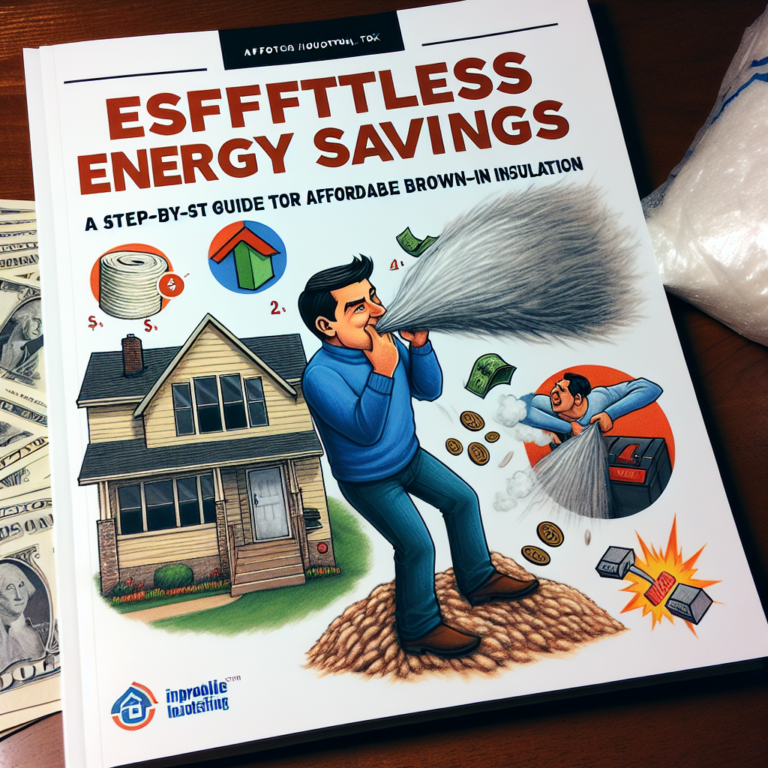-
Table of Contents
“Efficiently insulate your home with r49 blown insulation – keeping you warm and saving you money!”
Introduction
R49 blown insulation is a type of insulation material that is commonly used in residential and commercial buildings to improve energy efficiency and reduce heating and cooling costs. It is made up of loose fibers, typically made of fiberglass or cellulose, that are blown into the walls, floors, and attics of a building to create a barrier against heat transfer. This type of insulation is known for its high R-value, which measures its ability to resist heat flow, making it a popular choice for those looking to improve the energy efficiency of their homes or buildings. In this introduction, we will explore the benefits and uses of R49 blown insulation.
Benefits of R49 Blown Insulation for Your Home
Insulating your home is an essential step in creating a comfortable and energy-efficient living space. With the rising costs of energy and the increasing concern for the environment, homeowners are looking for ways to reduce their energy consumption and save money on their utility bills. One of the most effective ways to achieve this is by installing insulation in your home. While there are various types of insulation available, one that stands out for its superior performance is R49 blown insulation.
R49 blown insulation is a type of insulation that is made up of loose fibers, usually made from fiberglass, cellulose, or mineral wool. It is installed by blowing the fibers into the desired space using a special machine. This method of installation allows for a more even distribution of the insulation, ensuring that there are no gaps or voids that can compromise its effectiveness. R49 blown insulation is typically used in attics, walls, and floors, and it offers numerous benefits for homeowners.
One of the main benefits of R49 blown insulation is its high R-value. R-value is a measure of an insulation material’s ability to resist heat flow. The higher the R-value, the better the insulation’s performance. R49 blown insulation has an R-value of 49, which is one of the highest among all types of insulation. This means that it provides excellent thermal resistance, keeping your home warm in the winter and cool in the summer. With R49 blown insulation, you can significantly reduce your energy consumption and save money on your heating and cooling bills.
Another advantage of R49 blown insulation is its ability to fill in small and hard-to-reach spaces. Unlike traditional batt insulation, which comes in pre-cut sizes, blown insulation can be easily blown into tight corners, around pipes, and other obstacles. This makes it an ideal choice for insulating older homes with irregularly shaped attics or walls. The even distribution of the insulation also eliminates any potential air leaks, making your home more airtight and energy-efficient.
R49 blown insulation is also an eco-friendly option for homeowners. It is made from recycled materials, such as glass fibers or shredded newspaper, making it a sustainable choice for insulation. Additionally, the installation process of blown insulation produces minimal waste, making it a more environmentally friendly option compared to other types of insulation. By choosing R49 blown insulation, you are not only reducing your energy consumption but also contributing to a greener planet.
Furthermore, R49 blown insulation is a cost-effective solution for insulating your home. While the initial cost of installation may be slightly higher than other types of insulation, the long-term savings on your energy bills make it a worthwhile investment. Additionally, the even distribution of the insulation ensures that it remains effective for many years, without the need for frequent replacements or maintenance.
In conclusion, R49 blown insulation offers numerous benefits for homeowners looking to improve the energy efficiency of their homes. Its high R-value, ability to fill in small spaces, eco-friendliness, and cost-effectiveness make it a superior choice for insulation. If you are considering insulating your home, be sure to explore the option of R49 blown insulation and enjoy the many benefits it has to offer.
Understanding the Cost of Blown In Insulation Per Square Foot

Blown in insulation, also known as loose-fill insulation, is a popular choice for homeowners looking to improve the energy efficiency of their homes. It is a cost-effective and efficient way to insulate attics, walls, and other areas of a house. However, many homeowners are often confused about the cost of blown in insulation per square foot. In this article, we will delve into the factors that affect the cost of blown in insulation and provide a better understanding of the overall cost.
The cost of blown in insulation per square foot can vary depending on several factors. The first and most significant factor is the type of insulation material used. There are various types of blown in insulation materials available in the market, such as fiberglass, cellulose, and mineral wool. Each material has its unique properties and cost, which can significantly impact the overall cost of the project.
Fiberglass is the most commonly used blown in insulation material. It is made of tiny glass fibers and is known for its excellent thermal resistance. The cost of fiberglass blown in insulation per square foot can range from $0.50 to $1.50, depending on the thickness and quality of the material. On the other hand, cellulose insulation, made of recycled paper, is a more affordable option, with a cost of $0.30 to $0.80 per square foot. Mineral wool, made of rock or slag fibers, is the most expensive option, with a cost of $1.50 to $3.00 per square foot.
Apart from the type of insulation material, the size of the area to be insulated also plays a significant role in determining the cost per square foot. The larger the area, the more material will be required, resulting in a higher cost. Additionally, the accessibility of the area can also affect the cost. If the area is difficult to reach, such as a tight crawl space or a high ceiling, it may require more labor and equipment, increasing the overall cost.
Another factor that can impact the cost of blown in insulation per square foot is the R-value. R-value is a measure of the insulation’s thermal resistance, and the higher the R-value, the better the insulation’s ability to resist heat flow. The recommended R-value for blown in insulation varies depending on the climate zone, with colder regions requiring a higher R-value. A higher R-value means more insulation material will be needed, resulting in a higher cost per square foot.
The installation method can also affect the cost of blown in insulation. There are two main methods of installation – DIY and professional installation. DIY installation involves purchasing the insulation material and renting a blower machine to install it yourself. This method can save you money on labor costs, but it requires proper knowledge and skills to ensure the insulation is installed correctly. On the other hand, professional installation involves hiring a contractor who will provide the insulation material and install it for you. This method may cost more, but it ensures proper installation and can save you time and effort.
In addition to the factors mentioned above, the location and season can also affect the cost of blown in insulation per square foot. The cost may vary depending on the local market and the demand for insulation services. Additionally, some contractors may offer discounts during the off-season, making it a more cost-effective time to get your insulation installed.
In conclusion, the cost of blown in insulation per square foot can vary depending on several factors, including the type of insulation material, the size of the area, the R-value, the installation method, and the location. It is essential to consider these factors and get quotes from multiple contractors to get a better understanding of the overall cost. Investing in blown in insulation can significantly improve the energy efficiency of your home and save you money on heating and cooling costs in the long run.
Factors Affecting the Cost of R49 Blown Insulation Installation
R49 blown insulation is a popular choice for homeowners looking to improve the energy efficiency of their homes. This type of insulation is known for its high R-value, which measures the insulation’s ability to resist heat flow. The higher the R-value, the better the insulation is at keeping heat inside during the winter and outside during the summer. However, the cost of installing R49 blown insulation can vary greatly depending on several factors. In this article, we will discuss the factors that can affect the cost of R49 blown insulation installation.
One of the main factors that can affect the cost of R49 blown insulation installation is the size of the area that needs to be insulated. The larger the area, the more insulation material will be needed, resulting in a higher cost. Additionally, the shape and complexity of the space can also impact the cost. For example, insulating a simple rectangular attic will be less expensive than insulating a space with multiple angles and corners.
Another factor that can affect the cost of R49 blown insulation installation is the type of insulation material used. There are various types of blown insulation available, such as fiberglass, cellulose, and mineral wool. Each type has its own unique properties and cost. Fiberglass is the most commonly used insulation material and is generally the most affordable option. Cellulose, on the other hand, is made from recycled materials and is a more environmentally friendly option, but it can be more expensive. Mineral wool is known for its fire-resistant properties and is often used in areas where fire safety is a concern, but it is also more expensive than fiberglass.
The condition of the existing insulation can also impact the cost of R49 blown insulation installation. If there is already insulation in place, it will need to be removed before the new insulation can be installed. This can add to the overall cost of the project. Additionally, if the existing insulation is damaged or in poor condition, it may need to be replaced, which can also increase the cost.
The location of the property can also play a role in the cost of R49 blown insulation installation. The cost of living and labor rates can vary greatly from one region to another, which can impact the overall cost of the project. For example, the cost of installation in a rural area may be lower than in a major city.
The accessibility of the space that needs to be insulated is another factor that can affect the cost. If the space is difficult to access, such as a crawl space or a tight attic, it may require more time and effort to install the insulation, resulting in a higher cost. On the other hand, if the space is easily accessible, the installation process may be quicker and more straightforward, resulting in a lower cost.
Lastly, the contractor you choose to install the R49 blown insulation can also impact the cost. It is essential to choose a reputable and experienced contractor who will provide quality work. While it may be tempting to go with the cheapest option, it is crucial to consider the quality of work and materials used. A poorly installed insulation can lead to higher energy bills and potential damage to your home in the long run.
In conclusion, there are several factors that can affect the cost of R49 blown insulation installation. These include the size and complexity of the space, the type of insulation material used, the condition of existing insulation, the location of the property, the accessibility of the space, and the contractor chosen. It is essential to consider these factors when planning for R49 blown insulation installation to ensure that you get the best value for your money. By understanding these factors, you can make an informed decision and choose the best option for your home and budget.
Q&A
1. What is r49 blown insulation?
R49 blown insulation is a type of insulation material that is blown into attics or wall cavities to provide thermal resistance and improve energy efficiency in buildings. It is typically made of fiberglass or cellulose and has a high R-value, indicating its ability to resist heat flow.
2. How does r49 blown insulation compare to other types of insulation?
R49 blown insulation has a higher R-value compared to other types of insulation, such as batt or roll insulation. This means it provides better thermal resistance and can help reduce energy costs. It is also easier to install in hard-to-reach areas and can fill gaps and voids more effectively.
3. What are the benefits of using r49 blown insulation?
Some benefits of using r49 blown insulation include improved energy efficiency, reduced heating and cooling costs, and increased comfort in the home. It can also help reduce noise transmission and is environmentally friendly, as it is made from recycled materials. Additionally, it is a cost-effective option for insulating large or irregularly shaped spaces.
Conclusion
In conclusion, r49 blown insulation is a highly effective and efficient method of insulating homes and buildings. It provides superior thermal resistance, helping to keep indoor spaces warm in the winter and cool in the summer. Additionally, it is easy to install and can be used in various types of structures. With its ability to reduce energy costs and improve overall comfort, r49 blown insulation is a great choice for any insulation needs.














